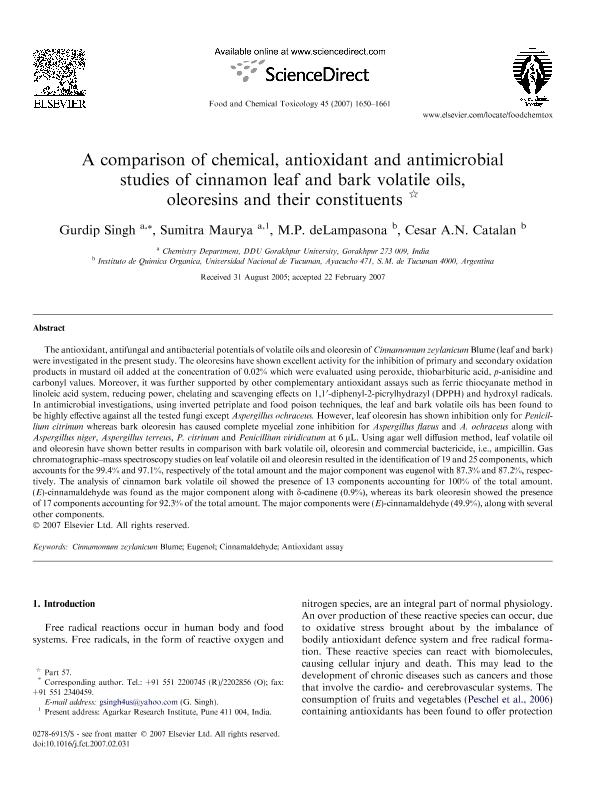Mostrar el registro sencillo del ítem
dc.contributor.author
Singh, Gurdip

dc.contributor.author
Maurya, Sumitra
dc.contributor.author
deLampasona, M.P.
dc.contributor.author
Catalan, Cesar Atilio Nazareno

dc.date.available
2020-03-17T14:31:25Z
dc.date.issued
2007-09
dc.identifier.citation
Singh, Gurdip; Maurya, Sumitra; deLampasona, M.P.; Catalan, Cesar Atilio Nazareno; A comparison of chemical, antioxidant and antimicrobial studies of cinnamon leaf and bark volatile oils, oleoresins and their constituents; Pergamon-Elsevier Science Ltd; Food And Chemical Toxicology; 45; 9; 9-2007; 1650-1661
dc.identifier.issn
0278-6915
dc.identifier.uri
http://hdl.handle.net/11336/99784
dc.description.abstract
The antioxidant, antifungal and antibacterial potentials of volatile oils and oleoresin of Cinnamomum zeylanicum Blume (leaf and bark) were investigated in the present study. The oleoresins have shown excellent activity for the inhibition of primary and secondary oxidation products in mustard oil added at the concentration of 0.02% which were evaluated using peroxide, thiobarbituric acid, p-anisidine and carbonyl values. Moreover, it was further supported by other complementary antioxidant assays such as ferric thiocyanate method in linoleic acid system, reducing power, chelating and scavenging effects on 1,1′-diphenyl-2-picrylhydrazyl (DPPH) and hydroxyl radicals. In antimicrobial investigations, using inverted petriplate and food poison techniques, the leaf and bark volatile oils has been found to be highly effective against all the tested fungi except Aspergillus ochraceus. However, leaf oleoresin has shown inhibition only for Penicillium citrinum whereas bark oleoresin has caused complete mycelial zone inhibition for Aspergillus flavus and A. ochraceus along with Aspergillus niger, Aspergillus terreus, P. citrinum and Penicillium viridicatum at 6 μL. Using agar well diffusion method, leaf volatile oil and oleoresin have shown better results in comparison with bark volatile oil, oleoresin and commercial bactericide, i.e., ampicillin. Gas chromatographic-mass spectroscopy studies on leaf volatile oil and oleoresin resulted in the identification of 19 and 25 components, which accounts for the 99.4% and 97.1%, respectively of the total amount and the major component was eugenol with 87.3% and 87.2%, respectively. The analysis of cinnamon bark volatile oil showed the presence of 13 components accounting for 100% of the total amount. (E)-cinnamaldehyde was found as the major component along with δ-cadinene (0.9%), whereas its bark oleoresin showed the presence of 17 components accounting for 92.3% of the total amount. The major components were (E)-cinnamaldehyde (49.9%), along with several other components. © 2007 Elsevier Ltd. All rights reserved.
dc.format
application/pdf
dc.language.iso
eng
dc.publisher
Pergamon-Elsevier Science Ltd

dc.rights
info:eu-repo/semantics/openAccess
dc.rights.uri
https://creativecommons.org/licenses/by-nc-sa/2.5/ar/
dc.subject
ANTIOXIDANT ASSAY
dc.subject
CINNAMALDEHYDE
dc.subject
CINNAMOMUM ZEYLANICUM BLUME
dc.subject
EUGENOL
dc.subject.classification
Química Orgánica

dc.subject.classification
Ciencias Químicas

dc.subject.classification
CIENCIAS NATURALES Y EXACTAS

dc.title
A comparison of chemical, antioxidant and antimicrobial studies of cinnamon leaf and bark volatile oils, oleoresins and their constituents
dc.type
info:eu-repo/semantics/article
dc.type
info:ar-repo/semantics/artículo
dc.type
info:eu-repo/semantics/publishedVersion
dc.date.updated
2020-03-11T18:29:05Z
dc.journal.volume
45
dc.journal.number
9
dc.journal.pagination
1650-1661
dc.journal.pais
Estados Unidos

dc.journal.ciudad
Amsterdam
dc.description.fil
Fil: Singh, Gurdip. Deen Dayal Upadhyay Gorakhpur University India; India
dc.description.fil
Fil: Maurya, Sumitra. Deen Dayal Upadhyay Gorakhpur University India; India
dc.description.fil
Fil: deLampasona, M.P.. Universidad Nacional de Tucumán; Argentina
dc.description.fil
Fil: Catalan, Cesar Atilio Nazareno. Consejo Nacional de Investigaciones Científicas y Técnicas. Centro Científico Tecnológico Conicet - Tucumán. Instituto de Química del Noroeste. Universidad Nacional de Tucumán. Facultad de Bioquímica, Química y Farmacia. Instituto de Química del Noroeste; Argentina. Universidad Nacional de Tucumán; Argentina
dc.journal.title
Food And Chemical Toxicology

dc.relation.alternativeid
info:eu-repo/semantics/altIdentifier/doi/https://dx.doi.org/10.1016/j.fct.2007.02.031
dc.relation.alternativeid
info:eu-repo/semantics/altIdentifier/url/https://www.sciencedirect.com/science/article/pii/S0278691507000889?via%3Dihub
Archivos asociados
